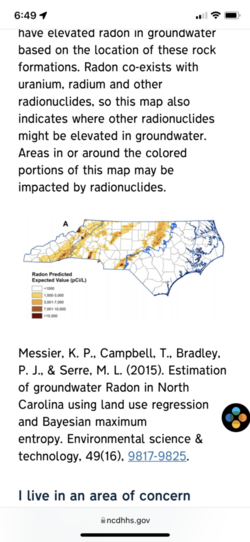Just bought a vacation in the mountains, and inspection shows radon problem (averaged 7.4 pCi/l during short term radon test, the EPA action level is 4.0 pCi/l). The place has a semi-finished basement, so I'm thinking maybe I can kill two (or perhaps three) birds with one stone here. Here's my plan ...
This basement is full-height, and has a rough plywood floor (not securely fastened down, thin plywood), along with open-to-framing walls and ceiling. The handyman who's worked on the place THINKS there is 2x8 treated joists under the plywood. So I'm thinking to pull up the plywood, install a vapor barrier, put a vent system in (an exhaust fan and an intake) to ventilate the space between grade and the joists. Then re-install the floor, perhaps with thicker or better-fastened plywood.
Seems like this well get me part of the way towards finishing out the space for a rec-room or the like, drywalling the walls and ceiling in the future. I hope the ventilation of the under-floor volume will lick the radon. The third "bird", maybe put 2" rigid foam on the walls so it becomes like an encapsulated crawlspace.
Thoughts ? I wonder if vapor barrier should go on the soil, or just beneath the floor ? Seems like it'd be nice not to have the treated joists exposed to living space.
This basement is full-height, and has a rough plywood floor (not securely fastened down, thin plywood), along with open-to-framing walls and ceiling. The handyman who's worked on the place THINKS there is 2x8 treated joists under the plywood. So I'm thinking to pull up the plywood, install a vapor barrier, put a vent system in (an exhaust fan and an intake) to ventilate the space between grade and the joists. Then re-install the floor, perhaps with thicker or better-fastened plywood.
Seems like this well get me part of the way towards finishing out the space for a rec-room or the like, drywalling the walls and ceiling in the future. I hope the ventilation of the under-floor volume will lick the radon. The third "bird", maybe put 2" rigid foam on the walls so it becomes like an encapsulated crawlspace.
Thoughts ? I wonder if vapor barrier should go on the soil, or just beneath the floor ? Seems like it'd be nice not to have the treated joists exposed to living space.


 I would take Radon over that electrical project!. In the radon reduction systems I have seen the vapor barrier/radon barrier goes as close to the living space as you can get it. On concrete foundations they put a layer for crushed rock down on the ground (many suggest putting it on geotextile) then the layer of heavy plastic is put on the crushed rock before the floor is poured. Concrete guys do not like pouring on plastic as it takes longer to float it so make sure they do not poke a fee drainage holes. The vapor barrier has to be sealed as tightly as possible. Radon is not just coming up through the floor it can come through the walls so you need to seal the walls. Ultimately you need air flow and a pressure differential between the space underneath and the living space above. If the floor and wall are leaky, its going to take a major effort to maintain the differential and more fan horsepower and long term power consumption. Some folks have tried to run the fans off of solar intermittently but everything I have read is 24/7 is far better.
I would take Radon over that electrical project!. In the radon reduction systems I have seen the vapor barrier/radon barrier goes as close to the living space as you can get it. On concrete foundations they put a layer for crushed rock down on the ground (many suggest putting it on geotextile) then the layer of heavy plastic is put on the crushed rock before the floor is poured. Concrete guys do not like pouring on plastic as it takes longer to float it so make sure they do not poke a fee drainage holes. The vapor barrier has to be sealed as tightly as possible. Radon is not just coming up through the floor it can come through the walls so you need to seal the walls. Ultimately you need air flow and a pressure differential between the space underneath and the living space above. If the floor and wall are leaky, its going to take a major effort to maintain the differential and more fan horsepower and long term power consumption. Some folks have tried to run the fans off of solar intermittently but everything I have read is 24/7 is far better.  So I've tried it in several rooms of the house itself, and readings are about 1 pCi/L. Should I be worried ?
So I've tried it in several rooms of the house itself, and readings are about 1 pCi/L. Should I be worried ? 